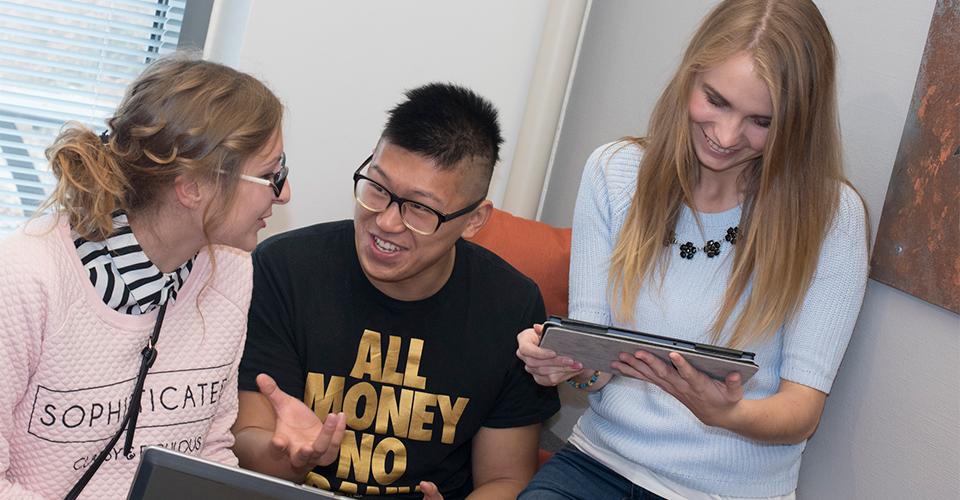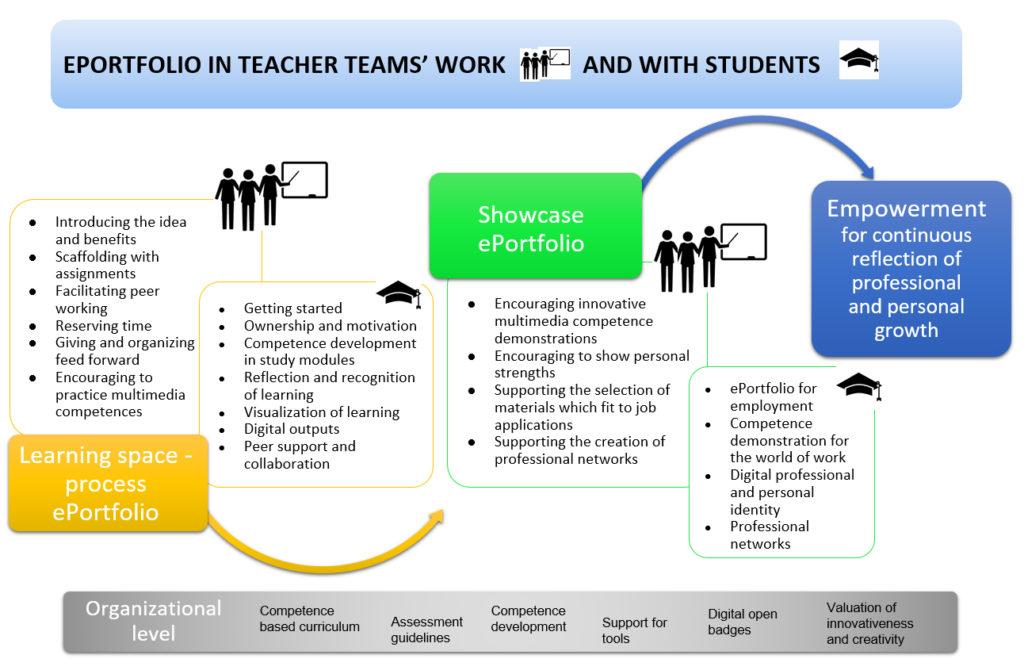
Irma Kunnari & Johanna Salmia
Innovative educational context at HAMK
At HAMK, authentic settings are created with close collaboration with work life, companies and regional stakeholders providing real-life learning environments for students. In every study module, the aim is to integrate students’ competence development with realistic work life phenomena. Teachers and students work together with the work life representatives in creating projects and problem based learning. New knowledge is co-created, which happens also beyond the study programmes in multidisciplinary projects and in international contexts. In addition, the four research units of HAMK, support the integration of RDI (research, development, innovation) and learning.
Students are central in competence-based education at HAMK. In practice, students’ ownership and responsibility for their learning is strengthened by involving them in planning and assessing their own learning as a part of active learning methods. Students explore real-life phenomena by combining the theoretical knowledge with 21st century skills practice (e.g. Ananiadou & Claro 2009). Learning processes include a lot of reflection by students, as reflection is important in higher education, providing deep learning (Cowan & Peacock 2017; Rogers 2001). Students are also encouraged to create personal career paths, beyond the study programmes utilising the expertise of the HAMK-wide network of partners. The professional growth of students is guided with performance appraisals on a yearly basis, which requires students to reflect their progress and think about their future in the world of work. Study modules are flexible so that students can build a variety of learning paths and benefit from different affordances in HAMK’s work based learning.
In the implementation of study modules, teachers work in teams guiding the students and facilitating their learning. Teacher teams design and implement the study modules, and they are also responsible for organising the assessment practices as a part of study module implementation. Assessment is embedded into the learning activities and students’ role in that is central. Assessment is considered to be an essential part of the learning process, consisting of continuous interaction and feedback. In addition, students are encouraged to create evidence of their competence development in multiple ways. Self-assessment and peer assessment are commonly used during the process, and when evaluating the final learning outcomes of the study modules.
The quality of learning is built by relying on the idea of constructive alignment (Biggs 2011), which emphasises the alignment between targeted competences and educational environment with pedagogical practices. Digitalisation is a basic requirement in modern professional world, and that’s why it is also part of the strategy at HAMK as well. Digital competences are developed in all levels of the organisation and digital tools are widely used in the learning processes, for example in team work and study module projects. Students produce multimedia digital outputs like common project plans, presentations, interactive photos, videos and infographics as an evidence of their competences. For peer learning and collaboration, they use team tools, for example Microsoft Teams to ease sharing materials and making meeting notes, Skype for Business to online meetings and WhatsApp to have a conversation to solve study module project-related daily issues. Students have the possibility to choose from a variety of digital tools, and teachers can agree with their students which tools are used for certain purposes. For some of them they get support from the HAMK IT organisation, but others are learned with the guidance from teachers. For teachers this requires continuous development of pedagogical practices and monitoring of new innovative applications. HAMK supports staff and students’ development by awarding Digital open badges (see e.g. Bauer, Siklander & Ruhalahti 2017), related to, for example, collaborative work, pedagogical competences and digital tools.
ePortfolio as a learning space and a showcase (Barrett 2010) has been introduced to the teachers, and now students from many study programmes have started to use them. In this article, we aim to clarify how ePortfolio can work as a tool in competence-based and student-centred higher education, where the ultimate goal of using ePortfolio is to empower students to build their professional profile and to find their place in the job market. We focus on teachers’ work at HAMK using ePortfolio as an assessment and guidance tool, which according to Yang, Tai and Lim (2016) “include showcasing and sharing learning artefacts, documenting reflective learning processes, connecting learning across various stages and enabling frequent feedback for improvements”. We are interested in how teachers can facilitate students’ ePortfolio creation, and what kind of preconditions for success can be identified from teachers’ point of view. The ideas and perspectives presented in this article are based on many discussions with HAMK teachers and educational developers, and on practical development work related to the ePortfolio usage in piloting bachelor programs. In addition, previous analyses made in the EEP- project have been utilized, like collection of best practices (Kunnari & Laurikainen 2017), students perspectives analyses (Kunnari, Laurikainen, & Torseke 2017) and analyses of employers’ perspectives (e.g. Kunnari 2018). In this sense, the approach of this article is applying the principles of practice-based or practitioner-based research (Heikkinen, de Jong, & Vanderlinde 2016), where practitioners themselves, including students and teachers, are analysing their own practices.
ePortfolio as a tool to empower students at HAMK
The digital portfolio has been recognised as having a lot of benefits in making the learning process transparent and empowering students to build their own professional growth following their personal interests. At HAMK, working with an ePortfolio needs to be embedded in the implementation of competence-based study modules. However, its role is not just to work in assessment of targeted competences in study modules, but also work in a wider perspective as a tool for supporting students’ professional growth. In that sense ePortfolios work as a tool in building students’ personal professional identity throughout the whole study time and beyond.
This transition from professional growth to professional life is implicit in the following diagram (Figure 1.). It illustrates how students and teachers can utilise ePortfolio in their professional development as a learning space and create their showcases step by step (see Barrett 2010). The ultimate aim is to empower students to continue using ePortfolios in their life-long learning and professional life. We want to clarify, according to our experiences in development and based on discussions with teachers, what is important for students and what teacher teams need to be aware of and take care of.

The critical point in ePortfolio work is getting it started. In the beginning, the most important role of teacher teams is to make students understand the idea and the importance of the ePortfolio work, and what kind of lifelong learning and professional benefits it might have in the future digital world. Students highlight the need for support and guidance from teachers, for example by introducing inspiring examples and choosing suitable environments (Kunnari et al. 2017). The ownership of ePortfolio work needs to be in students’ own hands, to assure the motivation and to boost the creativity. They need to have enough freedom to decide the content and the outlook of their ePortfolios.
However, the role of teachers in scaffolding the learning of students is crucial (Lave & Wenger 1991; Ruhalahti, Korhonen & Ruokamo 2016), especially in the starting point. Students need specific guidelines, assignments and feed forward. Regarding Learning space – process ePortfolio, productive way is to use ePortfolio as PLE (Personal Learning Environment, see Attwell 2007), where students return their assignments, that are then linked to the organisation’s learning environment for assessment (e.g. Moodle platform). Teacher teams’ important role is to encourage and to inspire students to practice their skills in making their competences transparent with digital tools. Innovative and not too restrictive assignments are needed, which make it possible for students to show their competences in multiple ways of using multimedia tools in ePortfolios. Also students’ reflection is done via ePortfolio, where teachers have an access to follow and are able to react making quick changes to the learning process if needed. Through student’s ePortfolios teachers will get the visibility to ensure of student’s professional development and personal growth.
Students emphasise that there needs to be time allocated for updating and building ePortfolio, and ePortfolio work needs to be embedded in their studies (Kunnari et al. 2017). Peer collaboration is also an essential part of the process, as it supports the development of new skills in ePortfolio work. Peer collaboration can create a safe environment to experiment and explore various digital applications. Furthermore, reflection of learning needs individual and collaborative time. In the study modules, student teams are creating visual multimedia outputs as evidence of competences for assessment. They also do a lot of collaboration in proving their learning, when working with other environments e.g. during freetime and hobbies. Teachers need to take that into account when planning study timetables and allocating time for peer work, which will help not only in reflection but also in understanding the different ways in building ePortfolios. The whole ePortfolio process needs time to think and work, that is assured by teachers.
Particularly regarding Showcase ePortfolio, teacher teams will be in the key role when extracting students’ personal strengths and helping them to demonstrate their competences in a professional way. Students are not always very good at identifying their personal characteristics beneficial for certain work context, but according to the previous analysis in EEP-project (e.g. Kunnari 2018) employers want to see “the person” behind the professional identity in the recruitment settings.
By building the bridges to the professional world via work life projects and by supporting the usage of professional social media environments, teachers can help students create the right kind of digital professional and personal profiles and to choose proper materials to apply to certain jobs. Digital portfolios cannot be created only in traditional school context, but the voice of worklife needs to be integrated into the ePortfolio creation. The ultimate goal is that students have their own professional networks, which support and motivate continuous updating of ePortfolios.
Preconditions in teachers’ work to success in guidance of ePortfolio
In this part, our aim is to identify how the previously presented elements (Figure 1.) can be successfully achieved from the teachers’ point of view. We approach this aim by describing the success factors at different levels: a) individual teacher level, b) teacher collaboration and teamwork level and c) organisational and leadership level.
a) Success factors in individual teacher level
Changing your pedagogical practices as a teacher can be demanding. Moving towards collaborative knowledge construction culture (Lonka 2015) means that you need to be able to design learning processes in a new way. The growth mindset of a teacher, instead of the fixed one, could help as you need to question your traditional practices and create new applications for how to work in competence based study modules, and how to utilise new digital tools in guidance and assessment. Teachers’ own experience with digital applications and in making their competences transparent in ePortfolio could help a lot, when trying to inspire the students. If teachers understand the benefits of ePortfolio in a wider professional context, and know different ways of how to construct it, they will feel more comfortable in their guidance work and can be an example to their students.
How teachers comprehend assessment as a part of competence based education really matters (Baartman, Bastiaens, Kirschner, & van der Vleuten 2007; Tillema, Kessels, & Meijers 2000). To be able to succeed in utilising ePortfolios, teachers need to see assessment and guidance as an integrated activity in the implementation of study modules when supporting competence development of students. Assessment is not just assessment of learning, but also assessment for learning, sometimes called as feed forward (Wimshurst & Manning 2013). Regarding the importance of reflection in learning (e.g. Cowan & Peacock 2017), assessment can also be considered assessment as learning, highlighting the indisputable importance of formative assessment as a continuous process enhancing students self-regulated learning (Clark 2012). Furthermore, it is crucial that teachers understand the central role of students in participating in assessment, as a self- and peer assessors. According to previous research related to the successful implementation of competence based study modules, teachers need to give space for students own ideas, which, in turn can strengthen students’ ownership for their own learning (Kunnari, Ilomäki, & Toom, 2018). Teachers need to value students’ creativity and they need to realise that competences can be demonstrated in various ways. In addition, assessment of competences in higher education is not restricted to the school environment, but needs to happen in real-life contexts. Teachers play an essential role in facilitating students to go beyond the school and build their professional networks at the same time they build their ePortfolios.
b) Success factors in teacher collaboration and teamwork
At best, ePortfolios are not only connected to some of the study modules, but they work as a tool for the whole learning path of students. That is why all the teachers in certain bachelor programmes, beyond the study modules, need to have common guidelines on how to utilise and guide ePortfolio work. If just an individual teacher requires students to use ePortfolios in some of the study modules, it is not enough for a successful ePortfolio process (Kunnari et al. 2017). Teachers’ personal pedagogical understanding creates a foundation for a good teacher collaboration. If an individual teacher thinks that the best way to build competences is to rely on collaborative knowledge construction with students, colleagues and work life representatives, then collaboration in ePortfolio work can be easier. Successful teamwork requires that teachers give up the individual and fragmented work orientation, and embrace more holistic and integrated teacher work.
In the implementation of study modules, teacher teams are challenged to build the assignments and assess the learning process together. Common competence goals of study modules steer this work. However, when assessment and ePortfolio creation is implemented within work related projects and environments, everything cannot be planned in advance.Teacher teams are required to regulate their actions according to the needs of students and to the emerging affordances, which emphasise the importance of teacher teams’ collective agility and flexibility (Kunnari, Ilomäki, & Toom 2018). In this kind of teamwork, teachers need to agree together how they give feedback and how they work with students, not as individuals but as a team. In an optimal situation, teacher teams recognise various personal strengths of team members and utilise them creatively. Every teacher needs to be able to support the students’ learning process by participating in the guidance of ePortfolio work, but they can give different inputs to the process according to their special professional competences and interests.
c) Success factors in organisational and leadership level
At an organisational level, successful ePortfolio work is enabled by embedding it into the competence based curriculum. Furthermore, ePortfolios’ role in assessment and in guidance of students professional growth needs to be clarified and communicated in organisational guidelines. The challenge can be that teachers and students consider the creation of ePortfolio as something extra, if they do not understand the idea and broader benefits of it. Students’ ownership for their ePortfolio creation is crucial, which changes the traditional role of teachers towards facilitators of learning and innovative organizers of assessment.
Teachers need support to change their role. They can be considered as learners, when developing new tools and practices in competence-based education (Kunnari & Ilomäki, 2016). Their leaders can assure that there is enough time and collaboration to support this kind of teacher learning. Concrete examples and common models can foster the development. The accomplishment of Digital open badges related to ePortfolio can strengthen the competences both with students and teachers. Badges work as stimulants and will motivate teachers to renew their teaching methods and the usage of ePortfolios in study modules. Requiring teachers to accomplish ePortfolio badges will take them to the same know-how level. Leaders can encourage teachers to try, explore and experiment different tools, and organise workshops and webinars to support adoption. They can value teachers’ innovativeness and creativity in motivating the students.
Conclusions
Innovative higher education needs innovative assessment and guidance tools. ePortfolios have a lot of benefits that support taking them widely into use with students. Students’ professional development can be more transparent and the assessment practices more engaging. Work life connections and peer collaboration are essential to get students motivated in updating their ePortfolios regularly. ePortfolios are not just for school, they are for life. Collaborative processes helps to understand how reflection can be improved and competences can be visualized in a personal and professional way.
Teachers need support to take over new tools and include ePortfolio work to the studies. Even though students own their ePortfolios, teacher teams facilitate the process. Teachers need to guide students especially at the beginning of the studies, when ePortfolios are taken into use, and reserve time for ePortfolio work. That creates continuity to the whole process. The ultimate goal is to great the feeling of ownership for students and to empower them to be creative.
Launching an ePortfolio comprehensively to higher education can be a long-term and subtle process. At the organisational level, common ePortfolio working methods and models enhance the process, but both students and teachers empowerment is achieved by encouraging them to create their own applications. Teachers need to recognise the benefits themselves by exploring new ways and learning together in teams. The engaging and meaningful ways to use ePortfolios can be developed together.

This article was produced in the Erasmus+ (KA2 action) funded project “Empowering Eportfolio Process (EEP)”. The beneficiary in the project is Häme University of Applied Sciences (FI) and the partners are VIA University College (DK), Katholieke Universiteit KU Leuven (BE), University College Leuven-Limburg (BE), Polytechnic Institute of Setúbal (PT) and Marino Institute of Education (IE). The project was implementated during 1.9.2016–30.11.2018.
Authors
Irma Kunnari, M.Ed (PhD Fellow in Educational Psychology) Principal lecturer, pedagogical developer and teacher educator in Häme university of applied sciences, School of Professional Teacher Education. She currently works as a project manager in Empowering Eportfolio Process (EEP) project, and has a broad experience in developing higher education and the relationships between HE institutions and the work field.
Johanna Salmia, MSc., Development Manager, digitalisation developer and teacher in Häme University of Applied Sciences, School of Bioeconomy and Bioeconomy-ICT program. She has been piloting ePortfolio in Bioeconomy-ICT program and has a broad experience in developing new digital and technical solutions in educational context.
References
Ananiadou, K., & Claro, M. (2009). 21st Century Skills and Competences for New Millennium Learners in OECD Countries. OECD Education Working Papers, 41. Retrieved 3 September from http://dx.doi.org/10.1787/218525261154
Attwell, G. (2007). The Personal Learning Environments – the future of eLearning? eLearning Papers. Retrieved 3 September 2018 from http://wiki.drupalschool.net/images/5/57/PLE_The_future_of_Elearning.pdf
Baartman, L. K., Bastiaens, T. J., Kirschner, P. A., & van der Vleuten, C. P. (2007). Evaluating assessment quality in competence-based education: A qualitative comparison of two frameworks. Educational Research Review, 2(2), 114–129.
Barrett, H. (2010). Balancing the Two Faces of ePortfolios. Educação, Formação & Tecnologias, 3 (1), 6–14. Retrieved 15 December 2017 from http://eft.educom.pt/index.php/eft/article/viewFile/161/102
Bauer, S., Siklander, P., & Ruhalahti, S. (2017). Motivation in digital open badge-driven learning in vocational teacher education. Ammattikasvatuksen aikakauskirja, 3/2017.
Biggs, J. B. (2011). Teaching for quality learning at university: What the student does. Maidenhead: McGraw-Hill Education.
Clark, I. (2012). Formative assessment: Assessment is for self-regulated learning. Educational Psychology Review, 24(2), 205–249.
Cowan, J., & Peacock, S. (2017). Integrating reflective activities in eportfolios to support the development of abilities in self-managed experiential learning. Reflective Practice, 18(5), 655–672.
Hakkarainen, K., Palonen, T., Paavola, S., & Lehtinen, E. (2004). Communities of networked expertise. Professional and educational perspectives. Oxford: Elsevier.
Heikkinen, H. L., de Jong, F. P., & Vanderlinde, R. (2016). What is (good) practitioner research? Vocations and Learning, 9(1), 1–19.
Lave, J., & Wenger, E. (1991). Situated learning: Legitimate peripheral participation. Cambridge: Cambridge University Press.
Lonka, K. (2015). Working document I. In European Parliament (Eds.) Innovative Schools: Teaching & Learning in the Digital Era – Workshop Documentation. Retrieved 3 September 2018 from http://www.europarl.europa.eu/RegData/etudes/STUD/2015/563389/IPOL_STU(2015)563389_EN.pdf
Koenen, A. K., Dochy, F., & Berghmans, I. (2015). A phenomenographic analysis of the implementation of competence-based education in higher education. Teaching and Teacher Education, 50, 1–12.
Kunnari, I. (2018). How can ePortfolios work in a big university hospital? In M. Laurikainen & I. Kunnari (eds.) Employers’ perspectives on ePortfolios. HAMK Unlimited Professional 8.6.2018. Retrieved 10 June 2018 from https://unlimited.hamk.fi/ammatillinen-osaaminen-ja-opetus/eportfolios-in-university-hospital
Kunnari, I., & Ilomäki, L. (2016). Reframing teachers’ work for educational innovation. Innovation
of Education and Teaching International, 53, (2), 167–178.
Kunnari, I., & Laurikainen, M. (eds.) (2017). Collection of Engaging practices on ePortfolio Process – Publication of the Empowering Eportfolio Process project. Retrieved 15 December 2017 from https://drive.google.com/file/d/0BxEnFq7yUumMUGV2V2VxVmNaNFU/view
Kunnari, I., Laurikainen, M., & Torseke, J. (2017). Triggering students to create ePortfolios. In I. Kunnari & M. Laurikainen (eds.) Students’ perspectives on ePortfolios. HAMK Unlimited Journal 15.12.2017. Retrieved 4 May 2018 from https://unlimited.hamk.fi/ammatillinen-osaaminen-ja-opetus/triggering-students-to-create-eportfolios
Kunnari, I., Ilomäki, L., & Toom, A. (2018). Successful Teacher Teams in Change – the Role of Collective Efficacy and Resilience. International Journal of Teaching and Learning in Higher Education, 30(1), 111–126.
Rogers, R. R. (2001). Reflection in higher education: A concept analysis. Innovative higher education, 26(1), 37–57.
Ruhalahti, S., Korhonen, A.-M., & Ruokamo, H. (2016). The dialogical authentic netlearning activity (DIANA) model for collaborative knowledge construction in mOOC. The Online Journal of Distance Education and e-Learning, 4(2), 58–67. Retrieved 3 September 2018 from http://urn.fi/URN:NBN:fi:amk-2017080714247
Tillema, H. H., Kessels, J. W. M., & Meijers, F. (2000). Competencies as building blocks for integrating assessment with instruction in vocational education: a case from the Netherlands. Assessment & Evaluation in Higher Education, 25(3), 265–278.
Wimshurst, K., & Manning, M. (2013). Feed-forward assessment, exemplars and peer marking: evidence of efficacy. Assessment & Evaluation in Higher Education, 38(4), 451–465.
Yang, M., Tai, M., & Lim, C. P. (2016). The role of e‐portfolios in supporting productive learning. British Journal of Educational Technology, 47(6), 1276–1286.





